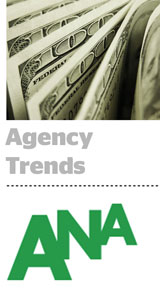 Fees remain the most common way for marketers to compensate advertising agencies, according to the 2013 Trends in Agency Compensation survey released by the Association of National Advertisers (ANA).
Fees remain the most common way for marketers to compensate advertising agencies, according to the 2013 Trends in Agency Compensation survey released by the Association of National Advertisers (ANA).
Out of 98 client-side marketers, 81% indicated that they continue to use some type of fee compensation for various agency types and services. Labor-based fees, which rose from 49% in 2010 to 65% in 2013, led the compensation trend.
At the same time, performance incentives received a boost, rising from 46% in 2010 to 61% in 2013. “It is possible that marketers are gravitating to performance incentives versus the newer methods of compensation [e.g., value-based fees and sales commissions] as a simpler and more precise way to tie at least some of their agency compensation to performance accountability,” wrote the report’s author, R3:JLB CEO David Beale.
Of those marketers using performance incentives, the survey showed a 15% increase since 2010 in the use of a “risk-reward” financial component. The risk-reward approach involves reducing the agency’s basic fee when goals are not met, while raising the compensation when performance goals are met or exceeded.
In addition, compared to 2010, cutting costs has greatly declined as a reason for changing compensation methods. Nearly 40% of the respondents said the main reason for changing their compensation method in 2013 was to improve agency performance. Cost-cutting on the other hand, saw a 13% decline between 2013 and 2010 when the impact of the recent recession was still fresh.
Other findings from the survey include the following:
- Three out of four advertisers measure performance incentives by agency performance reviews; 71% by brand awareness; and 52% by sales goals.
- More than half of the respondents (56%) continue to structure their agency incentive as a pure upside bonus on top of the negotiated “base” compensation.
- One-quarter of the marketers indicated that they were very satisfied with their current agency compensation method, while about 60% were somewhat satisfied.
- The use of a procurement/sourcing/purchasing team jumped from 56% in 2010 to 82% for 2013.












